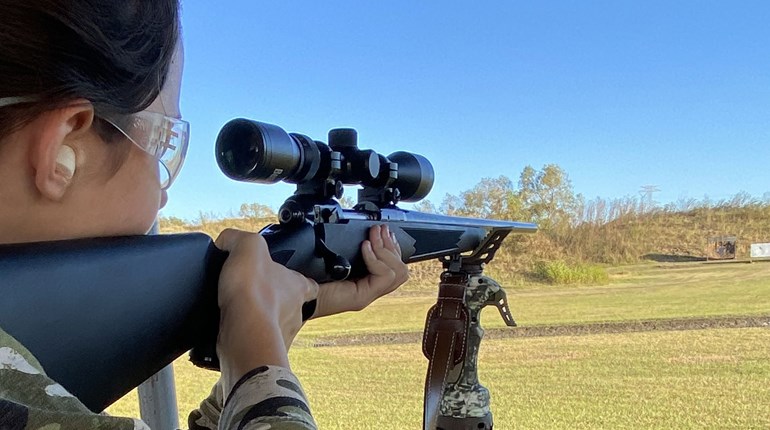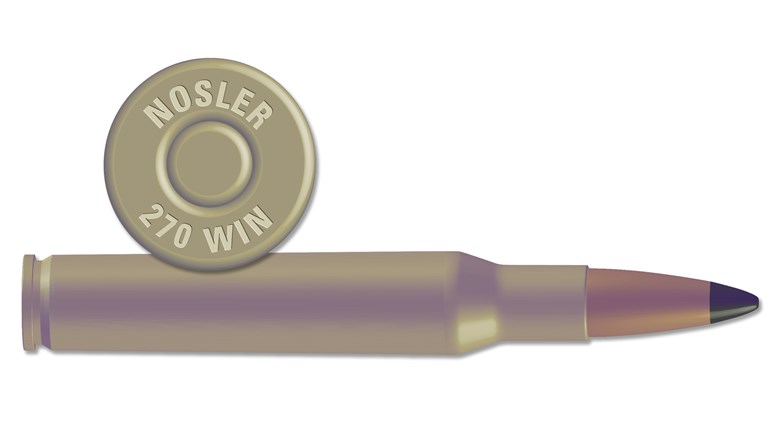
.270 Winchester
From the loins of the .30-06, the .270 Winchester first saw the light of day in 1925 in the form of the Winchester Model 54 bolt-action. The government cartridge was still the most popular, but “magnum mania” was beginning to take hold, and this was Winchester’s initial step into that arena. Not that anyone today would consider the .270 a magnum, but a 3140 fps muzzle velocity certainly turned heads in 1925.
As most know, it was Jack O’Connor and his exploits with this cartridge that endeared it to American hunters.
My first .270 was the first “other” caliber rifle I bought after my .30-06. With it I have killed several wild boar, more deer and pronghorn than I care to count, a couple of caribou and, yes, elk. The .270 Winchester is a very capable elk cartridge. What makes the .270 Winchester great is its combination of flat trajectory and mild recoil. A 130- to 140-grain bullet at 3100 fps placed in the heart-lung area of a game animal means a punched tag. The .270 is pleasant to shoot and easy to hit with, which probably has a lot to do with why you seldom see a used .270 Winchester in a gun store. Thems that buys ’em, keeps ’em.
7mm Remington Magnum
When Remington introduced the Model 700 in 1962 it—naturally—had to have a new cartridge to go with the new rifle. Enter the 7mm Remington Magnum. Credit is typically given to Warren Page, Les Bowman and Mike Walker for developing and producing the Big 7, as it is often called. Page was the gun editor for Field & Stream and touted the virtues of a wildcat 7mm Mashburn Magnum with nearly identical ballistics; Bowman was one of the old-school elk outfitters in Wyoming and a rifle nut, and Walker was the PR man at Remington.
As with most of the all-around cartridges listed here, the purpose of the 7mm Remington Mag. was to improve on the .30-06—more velocity for a flatter trajectory and greater killing power and more-or-less the same recoil. Big 7 delivered. For several years after its introduction the demand for a Model 700 in 7mm Remington Mag. outstripped the company’s ability to produce it. Today it remains as popular as ever. Several of my shooting buddies here in Wyoming swear by their 7 Mags and will not shoot anything else.
Where Big 7 really shines is with those relatively heavy-for-caliber bullets, from 160 grains on up. Drop 72 grains of MagPro behind a 160-grain Nosler Partition or AccuBond, and you’ll send those high-BC bullets out the muzzle at 3077 fps. Need even more punch? Try 62.5 grains of RL22 behind a 175-grain Nosler Partition for 2970 fps. Though the 7mm Remington Magnum would not be my first choice as a bear gun, either of these loads would suit me fine if I were to take one to Alaska.
.30-06 Springfield
The granddaddy of ’em all, benchmark, that from which all other cartridges are judged—all have been said accurately of the .30-06. Its success was certain. As the U.S. martial rifle and light machine gun cartridge for more than four decades and two world wars, plenty of soldiers-turned-hunters had firsthand experience with the cartridge. The surplus market ensured a long-term, cheap supply of ammo and components. Not to be overlooked, the .30-06 performed well on a wide variety of game.
If there was just one truly all-around cartridge—one that could handle everything from prairie dogs to Cape buffalo with relative efficiency—it would have to be the .30-06. Stoke it with 110- to 130-grain bullets, and while it may not be the most economical prairie dog puncher, it will do a passable job and not beat you up over a day of shooting. Think I’m full of bull saying the old ’06 is a buff rifle? Talk to fellow scribe and now African PH Sam Fadala. Sam dumped an old mbogo with a single 220-grain bullet out of an ’06 about three years ago.
About the only flies on the .30-06 is that it is old—103 years old to be exact. Some guys are just bored with it. Others cannot warm up to its centennial legacy; they have to have the newest and coolest. It still has me beat by a few decades, but as one who is getting long of tooth, perhaps I identify more closely with the ’06 than I might with other cartridges. You simply cannot go wrong buying a .30-06.
.300 Winchester Magnum
Souping up the .30-06 began in 1920 with the .300 H&H Magnum. When Winchester debuted the short-magnum concept with the .458 Winchester Magnum in 1956—not to be confused with the WSM cartridges introduced in 2001—and the .338 Winchester Magnum in 1958 Fred Huntington of RCBS fame took the .338 and necked it down to .30 caliber. The .30-.338 enjoyed some success, and it was thought that Winchester would bring it out as the .300 Winchester Magnum. But Winchester wanted more, so the company moved the shoulder forward about an eighth of an inch to gain powder capacity. The .300 Winchester Magnum has been an unqualified success since its introduction in 1963.
My experience with the .300 Winchester Magnum includes several wild pigs, a couple of deer and a pronghorn. Trajectory is clearly flatter than the ’06, and—no surprise—critters hit with the big .300 get slapped down with authority. If all you have ever shot has been an ’06, it will take some time to learn how to shoot the .300 Winchester Mag. effectively, but it is by no means abusive given a rifle of reasonable weight and a well-designed stock. Like the other magnum cartridges, it needs a 26-inch barrel to get the advertised velocity and energy. Brush busters may find that barrel length a bit awkward, but up in the treestand overlooking a bean field barrel length isn’t an issue. Hitting the deer at 300-plus yards is, and that’s where the big .300 shines.
.375 H&H Magnum
As the only non-native cartridge on this list, the .375 H&H Magnum may seem like too much gun for much of North American game. However, with magnum mania enjoying a renaissance the Three Seven Five is seeing more use on this side of the pond. Nilgai hunters in Texas swear it’s the best cartridge for that tough imported antelope from India and Pakistan. Of course, the cartridge earned its bones in Africa and is still thought of as the one basic rifle all hunters should have—much like our own .30-06. Many Alaska brown bear guides keep a .375 handy—with the obligatory tape over the muzzle—to bail out clients whose shooting isn’t up to par.
Firing bullets nearly twice as heavy as the .30-06 at nearly the same velocity, the .375’s downrange trajectory is the same as the lighter cartridge. For the hunter going to Africa, that means he or she can have a reasonable chance of nailing an impala at 300 yards as well has having the power to stop a Cape buffalo at 300 inches.
It has been said by many that the .375 H&H Magnum is the one truly all-around cartridge for hunting anywhere in the world. Given the size and variety of game that encompasses, I’d have a hard time arguing the contention despite my longtime love of the .30-06.



































